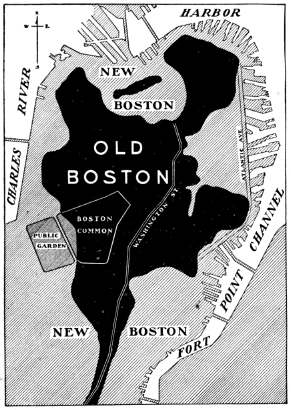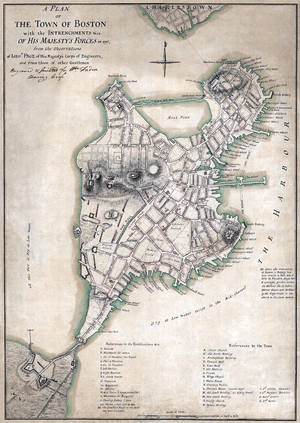Shawmut Peninsula facts for kids
The Shawmut Peninsula is a piece of land that sticks out into the water. The city of Boston, Massachusetts, was built on it. This land was first quite small, about 789 acres (3.2 square kilometers). But over time, it grew much bigger. Its size more than doubled because of special projects. These projects added new land to the peninsula during the 1800s. This was a big part of the history of Boston.
Contents
How the Land Was Formed
Like many places in Massachusetts, the Shawmut Peninsula was shaped by nature. Huge sheets of ice, called glaciers, moved across the land long ago. As they melted at the end of the last ice age, they left behind dirt and rocks. This created the hills and valleys we see today. When the first Europeans arrived, the peninsula was covered in thick forests.
The Original Hills of Shawmut
The land had three main hills. These hills were:
- Copps Hill: This hill was in the area now called the North End.
- Fort Hill: This hill was located where the Financial District is today.
- The Trimountain: This was the biggest hill. It had three peaks and very steep sides. People later shortened its name to Tremont. This area is now known as Beacon Hill.
To the south, a narrow strip of land connected the peninsula to the mainland. This strip was called Boston Neck. It led to a place called Roxbury, which is now a neighborhood in Boston.
Early English Settlement
The name "Shawmut" comes from an Algonquian word. Its exact meaning is not fully known. The first time "Shawmutt" was written down was in 1630. A settler named William Blaxton used the name. He invited John Winthrop to move his new settlement to the peninsula. Winthrop's group was living in what is now Charlestown.
Why Shawmut Was Chosen
The Charlestown area did not have enough fresh water. But the Shawmut Peninsula had a great spring. This spring was on the north side of what is now Beacon Hill. Because of this important water source, the settlers decided to move to Shawmut.
Adding New Land to Boston
Starting in 1820, people began to add new land to the peninsula. These projects continued until 1900. This process is called land reclamation. It created large new areas for Boston.
New Neighborhoods from New Land
Some of Boston's well-known neighborhoods were built on this new land. These include:
- The South End
- The Back Bay
- Fenway-Kenmore
A part of the Back Bay area, called the Back Bay Fens, is still a freshwater urban wild. It is a reminder of the salt marshes that once surrounded the Shawmut Peninsula.
Why Land Was Added
Adding new land was seen as a great help to the community. There were two main reasons for this:
- Cleaner Environment: The areas around the peninsula used to be smelly tidal flats. They had become dirty with sewage. Adding new land helped get rid of these unpleasant areas.
- Valuable Space: The new land created some of the most valuable property in New England. This new space was used for homes and businesses.
Today, it would be very difficult to do such a project. Modern environmental regulations protect wetland ecosystems. But back then, people thought it was a very good idea.



